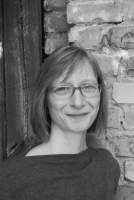Dr. Uta Karstein

Areas of Interest
- Sociology of art and architecture
- Historical sociology
- Sociology of religion e.g. relationship between art, architecture and religion in the 19th century
- Discourses on art autonomy since 1800
- More recent art scandals
Coping with Autonomy: How Religion Dealt With the Emergence of an Autonomous Art Field in 19th Century Germany
In addressing the question of the demarcation and determination of the relationship between religion and other social structures, practices, and semantics, the planned project focuses primarily on how the relationship between art and religion has changed since the nineteenth century in (Western) Europe. It starts with the historical situation in which art developed into a highly complex and differentiated area of society with a multitude of actors and organizations. The works of Immanuel Kant, Karl Philipp Moritz or Friedrich Schiller added the idea of artistic freedom, which provided influential semantics. In terms of the KFG's research programme, this concept can be characterized as a guiding idea that has proved particularly powerful in art related discourse. Religious actors have also had to position themselves in relation to the idea of artistic freedom.
Against this background, the emergence of an independent art field has often been described as a process of emancipation. Sociological work on this topic is not free of a certain positive emphasis on this historical fact (cf. for example Luhmann or Bourdieu). Conversely, the development of religion under the conditions of modernity is sometimes characterized as an involuntary retreat and a forced restriction to oneself and one's own core business. Compared to such narratives, the relationship between art and religion in German-speaking countries in nineteenth century Europe exhibits an astonishing degree of ambivalence: Not all artists welcomed the new status of autonomy or rejected per se a further usurpation of art—for instance by religion. Moreover, religious representatives and religiously committed lay people were by no means passive towards the new conditions, but rather, were creatively engaged. Their observation that Christianity or Christian churches increasingly appeared as a "separate area alongside other circles of life" led to a series of revealing processing strategies in the middle of the nineteenth century.
The project will take a closer look at two such strategies. One strategy involved the Church effort to keep their own concerns and expectations of art present in the art field. Churches performed this, for example, by founding their own art organizations such as Christian art associations or through museums, which simultaneously attempted to popularize specifically religious criteria for the evaluation of artistic works (level of differentiation). Another strategy involved the adaptation of secular semantics such as the concept of ‘good taste’ and other art historical terminology in order to sensitize religious circles to artistic quality (level of distinction). The resulting contact zone was intended to actively counteract the lamented separation of art and religion. In a second step, the project will examine the intentional and non-intentional effects of these activities in detail. The latter in particular proves to be revealing: The ongoing presence of religious actors and perspectives in the art field led to renewed efforts to demarcate and draw boundaries in the field itself. In addition, the implementation of aesthetic as well as art-historical or cultural-historical semantics within the religious field fostered lasting secular perspectives on religion because they led to a process of culturalization in which the religious actors and institutions played an active role.
For this purpose, archival materials on Christian art associations and the art criticism in the journals they published (1850-1914) will be evaluated. In order to be able to reconstruct the reactions in the art field to the activities of the religious actors, other relevant (secular) art magazines in this period will also be examined.
In addition, museums and galleries that were founded by religious actors and remain in religious sponsorship today will be studied. These include the Diözesanmuseum Kolumba in Cologne (founded in 1853, still in existence today), the Kunstraum der Deutschen Gesellschaft für Christliche Kunst in Munich (founded in 1898 and still active today) and the Stiftung Christliche Kunst with its collection in Lutherstadt Wittenberg (founded in 2001). The way in which objects are presented, how exhibition themes are curated, and the way in which each are semantically coded will be comparatively examined.
Biography
Head of the Cultural Management Department at the Cultural Studies Institute, Leipzig University (Germany)
Habilitation (postdoctoral qualification), Technische Universität Dresden "Religion im 19. Jahrhundert. Ästhetik – Öffentlichkeit – Autonomie" (Germany)
Head of transfer project "Wege der Organisationsentwicklung im Kulturbereich" (Germany)
Visiting Scholar, Queen Mary University London (UK)
Research Assistant at the Cultural Studies Institute, Cultural Sociology Department, Leipzig University (Germany)
Research Assistant, Institute for Sociology, TU Dresden (Germany)
Research Assistant, SMWK Research Project „Sakralbauten in der Moderne. Gemeindlicher Kirchenbau in der Zeit beschleunigter Urbanisierung als 'eigensinniger' Prozess (ca. 1880–1930),“ Cultural History Department, Leipzig University (Germany)
Research Assistant, Cultural Studies Institute, Cultural Sociology Department, Leipzig Universtiy (Germany)
PhD (Dr.) in Sociology, "Konflikt um die symbolische Ordnung. Genese, Struktur und Eigensinn des religiös-weltanschaulichen Feldes in der DDR" („summa cum laude“), Leipzig University (Germany)
Research Assistant, DFG Research Project "Generationenwandel als
religiöser und weltanschaulicher Wandel," Institute for Practical Theology, Leipzig University (Germany)
Under- and Postgraduate Studies of Sociology, Cultural Studies and Psychology at Free University Berlin and Humboldt Universität Berlin (Germany)
Relevant Publications
- Karstein, Uta. "Religious Architecture as a Public Matter? Some Insights about Church Building in the Modern Era." In Space and Place as a Topic for Public Theologies, edited by Thomas Wabel, Katharina Eberlein-Braun, and Torben Stamer. Zürich: LIT Verlag, 2022.
- Karstein, Uta. "Geschmackserziehung im 'Kitschzeitalter': Zur Formierung der Sinne im 19. Jahrhundert." In Wahrnehmung als soziale Praxis, edited by Christiane Schürkmann, and Nina Tessa Zahner, 111–32. Wiesbaden: Springer VS, 2021.
- Sammet, Kornelia, and Uta Karstein. "Touristifizierung von Religion und Spiritualisierung von Tourismus: Erkundungen am Beispiel von religiösen Wanderwegen im Schwarzwald." Zeitschrift für Religion, Gesellschaft und Politik 5, no. 1 (2021): 88–111.
- Karstein, Uta, and Monika Wohlrab-Sahr. "Culture." In Soziologie – Sociology in the German Speaking World, edited by Bettina Holstein, Rainer Greshoff, Uwe Schimank, and Anja Weiß. Special Issue, Soziologische Revue (2021): 9–26.
- Karstein, Uta. "Konkurrenzbeziehungen: Allgemeine und konfessionelle Kunstvereine im Kunstfeld des 19. Jahrhunderts." IASL 54, no. 2 (2020): 334–44.
- Karstein, Uta. "Eine Frage des Geschmacks? Christliche Kunstvereine und der Kirchenbau im 19. Jahrhundert." In Geschichte und Gesellschaft: Zeitschrift für historische Sozialwissenschaft 45, no. 2 (2019): 161–90.
- Karstein, Uta. "Die zwei Romantiken: Malerei des 19. Jahrhunderts zwischen Kunst- und Bekenntnisreligion." In Zeitschrift für Religion, Gesellschaft und Politik 3, no. 1 (2019): 131–50.
- Karstein, Uta, and Nina Tessa Zahner, ed. Autonomie der Kunst?! Zur Aktualität eines gesellschaftlichen Leitbildes. Wiesbaden: Springer VS, 2017.
- Karstein, Uta, and Thomas Schmidt-Lux. "Die materiale Seite des Religiösen: Soziologische Perspektiven und Ausblicke." In Architektur & Artefakte: Zur materialen Seite des Religiösen, edited by Uta Karstein, and Thomas Schmidt-Lux, 2–24. Wiesbaden: Springer VS, 2017.
- Karstein, Uta, and Nina Tessa Zahner. "Autonomie der Kunst? Dimensionen eines kunstsoziologischen Problemfeldes." In Autonomie der Kunst? Zur Aktualität eines gesellschaftlichen Leitbildes, edited by Uta Karstein, and Nina Tessa Zahner, 1–48. Wiesbaden: Springer VS, 2017.
- Zahner, Nina Tessa, and Uta Karstein. "Autonomie und Ökonomisierung der Kunst: Vergleichende Betrachtungen von System- und Feldtheorie." In "Autonomie Revisited: Beiträge zu einem umstrittenen Grundbegriff für die Beobachtung von Wissenschaft, Kunst und Politik," edited by Martina Franzen, Arlena Jung, David Kaldewey, and Jasper Korte. Special Issue, Zeitschrift für theoretische Soziologie (2014): 188–210.


